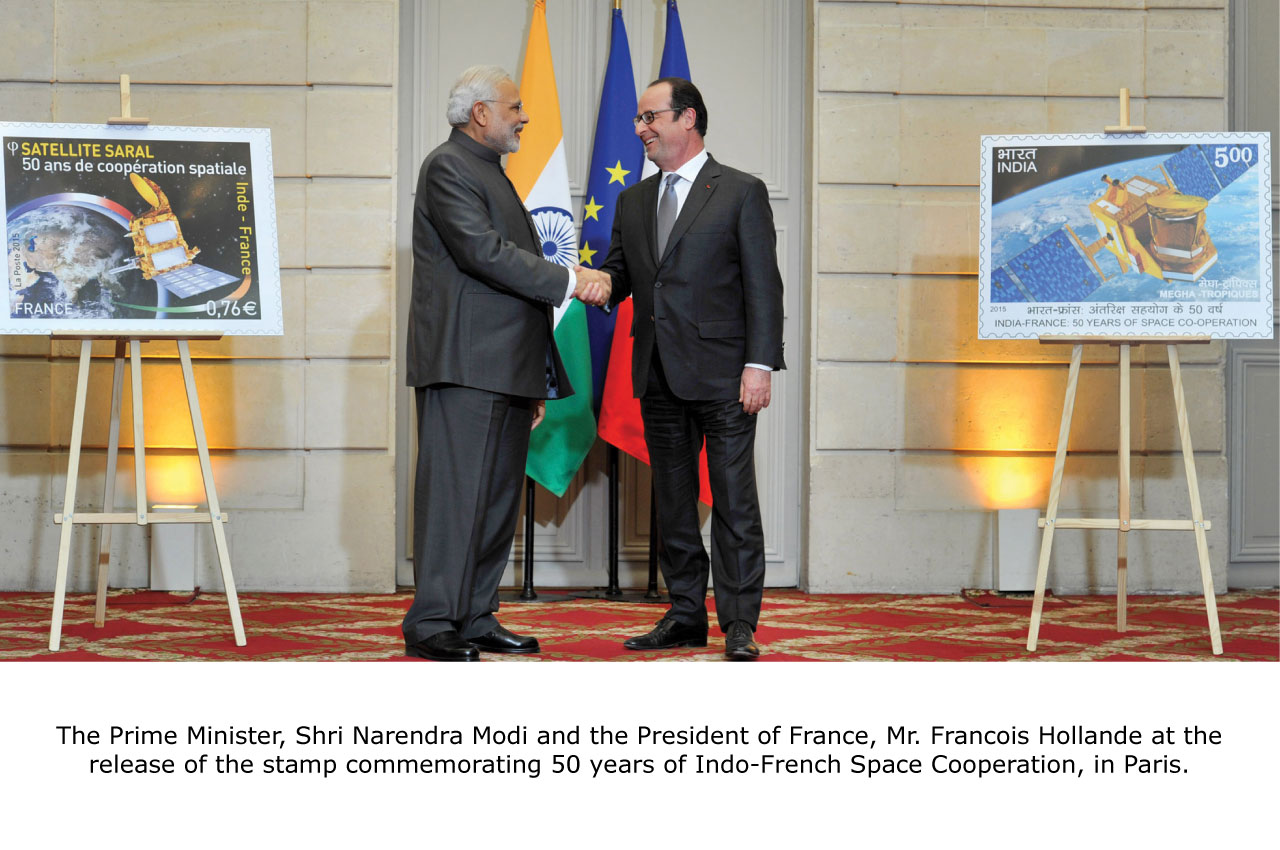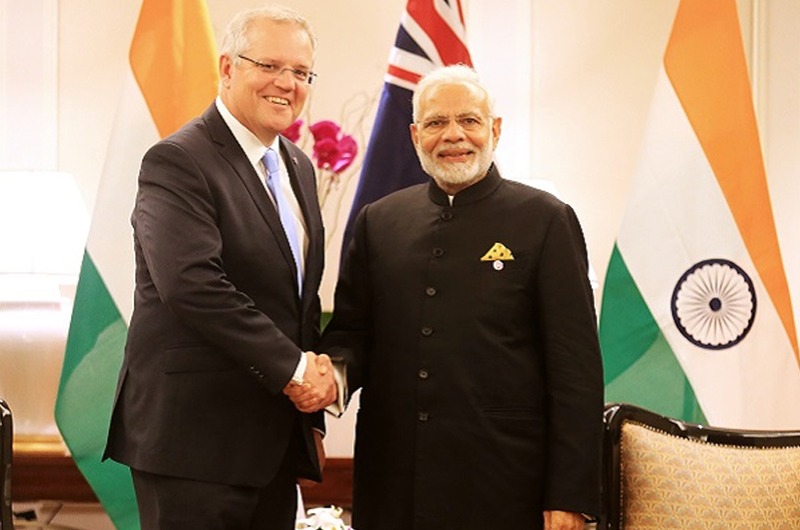A Time-Tested Partnership
India and France view each other as important partners in Space Technology and Applications and have a vibrant bilateral co-operation for more than five decades. Since 1964, the Indian Space Research Organization (ISRO – Indian government space agency) and Centre National d’Etudes Spatiales (CNES – French government space agency) have a longstanding partnership for peaceful uses of outer space. This longstanding partnership led to the realization of world-class joint projects whose scientific outputs have benefitted the entire scientific community.
Birth and Evolution of Space Co-Operation:
The partnership began in May 1964 when India and France entered into a protocol agreement for co-operation in space research. India was provided with four French Centaure rockets with payloads for vapor cloud experiments. Later, under the supervision of the French team, 50 sounding rockets were realized and launched from the Thumba Equatorial Rocket Launching Station (TERLS) near Trivandrum in Kerala. Drawing from this experience, a series of Rohini sounding rockets were developed by India for conducting scientific and technological experiments.
The 1970s saw the transfer of technology for the Viking liquid rocket engines from France to India. A group of Indian scientists worked at French facilities for helping to develop the earth storable propulsion engine. The Viking engine later evolved into the present day high performance Vikas engine used in PSLV and GSLV. In June 1977, a co-operation agreement in the space field was signed between the two countries. Following this, India’s first experimental communication satellite (APPLE) was launched by the French Ariane-1 (V-3) launch vehicle in 1981. Another Indian communication satellite, INSAT-1C was launched on-board French Ariane-3 launch vehicle in 1988.
In the 1990s, five of the Indian 2nd generation communication satellites were launched onboard Ariane-4 launch vehicle on commercial basis. These satellites were INSAT-2DT, INSAT-2A, INSAT-2B, INSAT-2C and INSAT-2E. All these satellites were successfully placed in the pre-determined orbits and served their useful service life. For strengthening and increasing the co-operation between ISRO and CNES, an agreement was signed in November 1993. This agreement included study of co-operative programs in satellites and balloons for space research and applications. This followed another agreement in 1998 where Space was defined as a pillar of strategic partnership between the two countries.
As many as six Indian communication satellites were launched on-board Ariane-5 rockets on commercial basis during the period 2000 to 2010. These included INSAT-3B, INSAT-3C, INSAT-3A, INSAT-3E, INSAT-4A and INSAT-4B. During this period, the mass of the satellites gradually increased from 2 tonnes to 3 tonnes thereby increasing their transponder carrying capacity. An Indo-French framework agreement was signed in September 2008 in order to set up joint research programmes, instruments and satellites. This agreement covered the following important areas of mutual interest among others:
• Study of climate change with earth observation satellites.
• Development of micro satellites and mini-satellites for scientific purposes
• Joint research and development activities
• Development of ground infrastructure for joint satellite missions
• Organization of combined training programmes
• Exchange of technical and scientific personnel
The importance of this co-operation was underlined by the visit of the French President to ISRO in 2010. This period saw a new beginning of development of joint satellites between the two countries.
Development of Joint Satellites
On October 12, 2011, India’s PSLV-C18 successfully injected into orbit a 1000-kilogram Indo-French weather observation satellite called Megha-Tropiques (Megha meaning ‘clouds’ in Sanskrit and Tropiques meaning tropics in French). This satellite was jointly developed, realized and operated by the two countries. For the last five years, the satellite has been monitoring the atmospheric water vapour, rains, clouds and temperature in the tropical belts on either sides of the Equator. The scientific data received from the satellite has been very useful and is periodically reviewed by the Joint Steering Committee on Megha-Tropiques. Recently, the MoU on Megha-Tropiques was extended.
Another satellite, SARAL (Satellite with ARgos and ALtika) jointly developed by ISRO and CNES, was launched on-board PSLV C-20 on 25 February 2013. This satellite uses precise radar altimetry for oceanographic studies such as observation of ice, coastal areas, continental water bodies and the waves height. The satellite has also helped in better understanding of climate and weather forecasting capabilities through improvement in coupled ocean-atmosphere models and bio-chemistry models. The last Annual review meeting of SARAL was held at Toulouse in October 2015.
Interaction with Commercial Enterprises:
Under a commercial launch service agreement between Antrix Corporation Limited , the commercial arm of ISRO and EADS-Astrium, France, an advanced remote sensing satellite, SPOT-6 built by EADS-Astrium was successfully launched onboard PSLV C-21 on September 9, 2012. The next satellite in the series, SPOT-7 was successfully launched by PSLV C-23 on June 30, 2014. Together, the two satellites with highly responsive sensors, wide swath and high resolution have enhanced the remote sensing capacity. Earlier, ISRO was also involved in the realization of HYLAS (acronym for Highly Adaptable Satellite) satellite with EADS-Astrium for high definition television and interactive broadband services for European countries. French industries have also proven to be reliable suppliers for components, spares and equipment for the Indian Space Programme. The Bangalore Space Expo held in November 2014 was well attended by leading industries from France.
From 2011 to 2015, as many as six Indian communication satellites have been launched on-board Ariane-5 rockets. These include GSAT-8, GSAT-10, INSAT-3D, GSAT-7, GSAT-16 and GSAT-15. The advanced communication satellite, GSAT-15 launched on November 10, 2015 was the last one in the series. In all, 19 Indian satellites have so far been launched by Arianespace rockets.
France has proven to be a reliable supplier for components, spares and equipment for the Indian Space Programme. More than 20 French companies including Airbus Defence and Space, SAFT, SAFRAN, MPA Industries, Hutchinson and Constellium have been regular suppliers for various ISRO activities.









